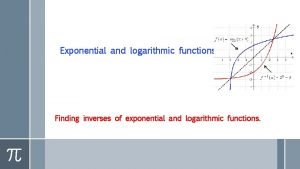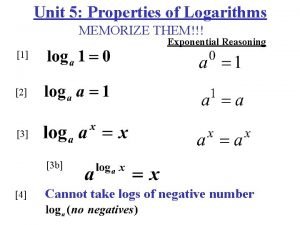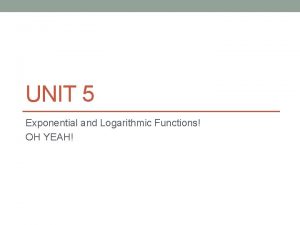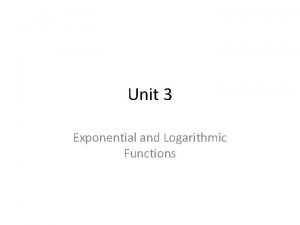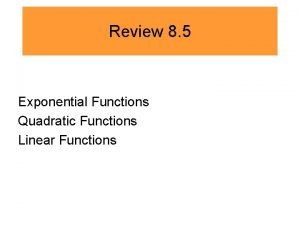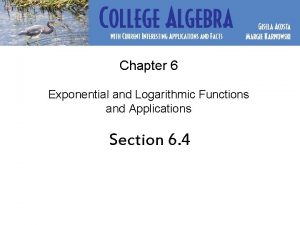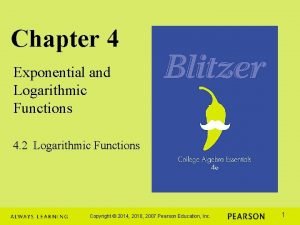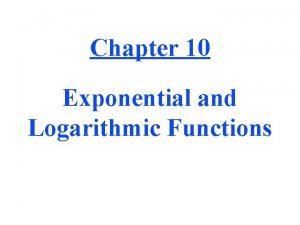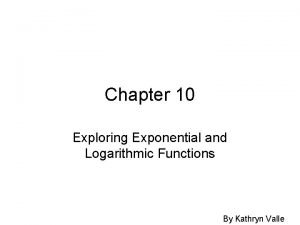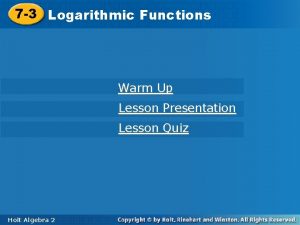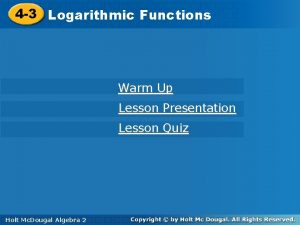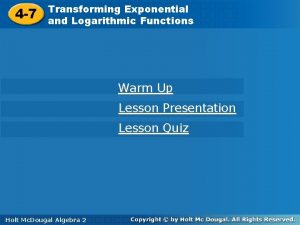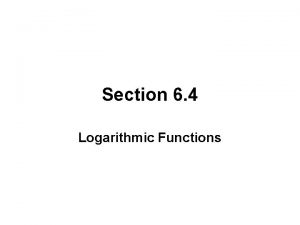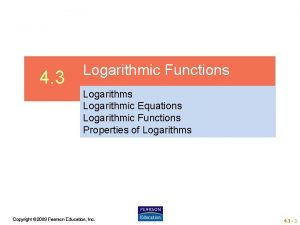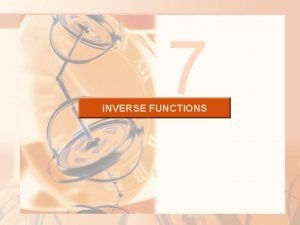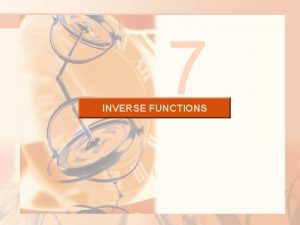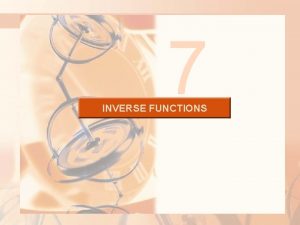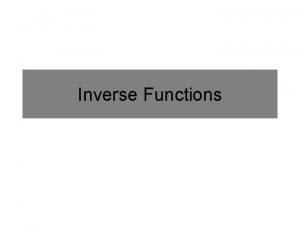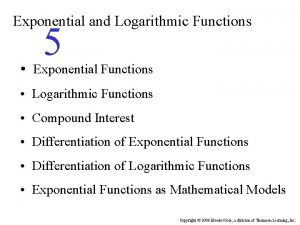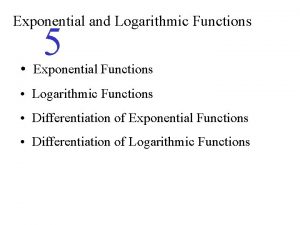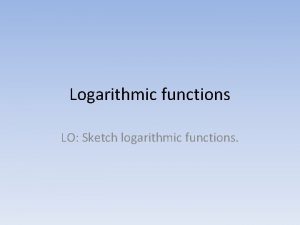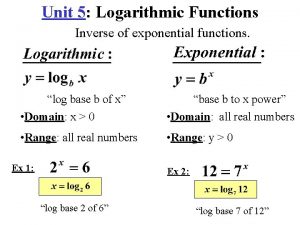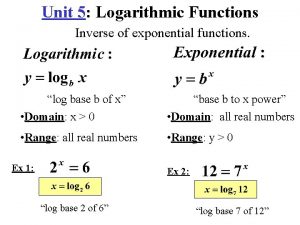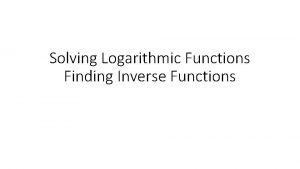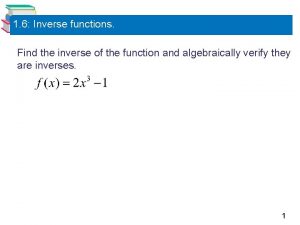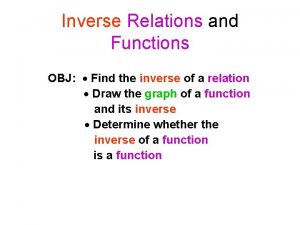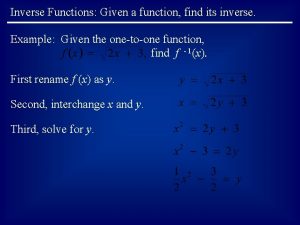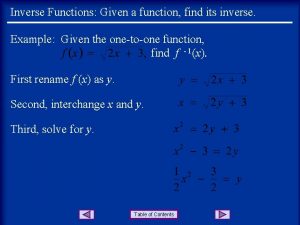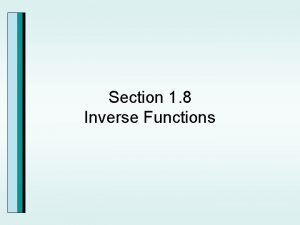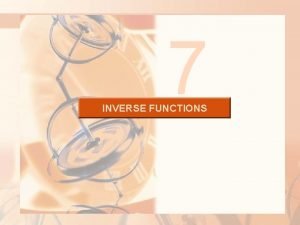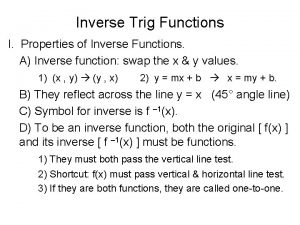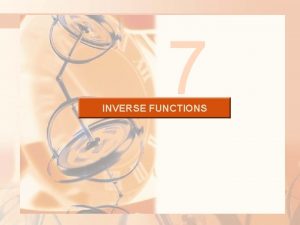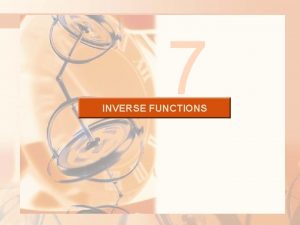WarmUp 10 2 Logarithmic Functions Find the inverse
































- Slides: 32

Warm-Up 10. 2 Logarithmic Functions Find the inverse of each function. 1) f(x) = x + 10 2) g(x) = 3 x 3) h(x) = 5 x + 3 4) j(x) = ¼x + 2

10. 2 Logarithmic Functions • Write equivalent forms for exponential and logarithmic equations. • Use the definitions of exponential and logarithmic functions to solve equations.

10. 2 Logarithmic Functions Rules and Properties Equivalent Exponential and Logarithmic Forms For any positive base b, where b 1: bx = y if and only if x = logb y. Exponential form Logarithmic form

Example 1 6. 3 Logarithmic Functions a) Write 27 = 128 in logarithmic form. log 2 128 = 7 b) Write log 6 1296 = 4 in exponential form. 64 = 1296

Example 2 6. 3 Logarithmic Functions a. Solve x = log 2 8 for x. 2 x = 8 x= 3 b. logx 25 = 2 x 2 = 25 x= 5

Practice 6. 3 Logarithmic Functions c. Solve log 2 x = 4 for x. 24 = x x = 16

6. 3 Logarithmic Functions Example 3 a. Solve 10 x = 14. 5 for x. Round your answer to the nearest tenth. log 1014. 5 = x x = 1. 161

Rules and Properties 6. 3 Logarithmic Functions One-to-One Property of Exponential Functions If bx = by, then x = y.

6. 3 Logarithmic Functions Example 4 Find the value of the variable in each equation: a) log 2 1 = r 2 r = 1 20 = 1 r=0 b) log 7 D= 3 73 = D D = 343

6. 3 Logarithmic Functions Practice Find the value of the variable in each equation: 1) log 4 64 = v 2) logv 25 = 2 3) 6 = log 3 v

Practice Solve each equation for x. Round your answers to the nearest hundredth. 1) 10 x = 1. 498 2) 10 x = 0. 0054 Find the value of x in each equation. 3) x = log 4 1 4) ½ = log 9 x

Properties of Logarithmic Functions Objectives: • Simplify and evaluate expressions involving logarithms • Solve equations involving logarithms

Properties of Logarithms For m > 0, n > 0, b > 0, and b 1: Product Property logb (mn) = logb m + logb n

Example 1 given: log 5 12 1. 5440 log 5 10 1. 4307 log 5 120 = log 5 (12)(10) = log 5 12 + log 5 10 1. 5440 + 1. 4307 2. 9747

Properties of Logarithms For m > 0, n > 0, b > 0, and b 1: Quotient Property m logb = logb m – logb n n

Example 2 given: log 5 12 1. 5440 log 5 10 1. 4307 12 log 5 1. 2 = log 5 10 = log 5 12 – log 5 10 1. 5440 – 1. 4307 0. 1133

Properties of Logarithms For m > 0, n > 0, b > 0, and any real number p: Power Property logb mp = p logb m

Example 3 given: log 5 12 1. 5440 log 5 10 1. 4307 log 5 1254 = 4 log 5 125 = 4 3 = 12 5 x = 125 53 = 125 x=3

Practice Write each expression as a single logarithm. 1) log 2 14 – log 2 7 2) log 3 x + log 3 4 – log 3 2 3) 7 log 3 y – 4 log 3 x

4 minutes Warm-Up Write each expression as a single logarithm. Then simplify, if possible. 1) log 6 6 + log 6 30 – log 6 5 2) log 6 5 x + 3(log 6 x – log 6 y)

Properties of Logarithms For b > 0 and b 1: Exponential-Logarithmic Inverse Property logb bx = x and b logbx = x for x > 0

Example 1 Evaluate each expression. a) b)

Practice Evaluate each expression. 1) 7 log 711 – log 3 81 2) log 8 85 + 3 log 38

Properties of Logarithms For b > 0 and b 1: One-to-One Property of Logarithms If logb x = logb y, then x = y

Example 2 Solve log 2(2 x 2 + 8 x – 11) = log 2(2 x + 9) for x. log 2(2 x 2 + 8 x – 11) = log 2(2 x + 9) 2 x 2 + 8 x – 11 = 2 x + 9 2 x 2 + 6 x – 20 = 0 2(x 2 + 3 x – 10) = 0 2(x – 2)(x + 5) = 0 x = -5, 2 Check: log 2(2 x 2 + 8 x – 11) = log 2(2 x + 9) log 2 (– 1) = log 2 (-1) undefined log 2 13 = log 2 13 true

Solve for x. Practice 1) log 5 (3 x 2 – 1) = log 5 2 x 2) logb (x 2 – 2) + 2 logb 6 = logb 6 x

Exponential Growth and Decay Objectives: • Determine the multiplier for exponential growth and decay • Write and evaluate exponential expressions to model growth and decay situations

Modeling Bacteria Growth Time (hr) 0 Population 25 1 2 3 4 5 6 50 100 200 400 800 1600 Write an algebraic expression that represents the population of bacteria after n hours. The expression is called an exponential expression because the exponent, n is a variable and the base, 2, is a fixed number. The base of an exponential expression is commonly referred to as the multiplier.

Example 1 Find the multiplier for each rate of exponential growth or decay. a) 9% growth 100% + 9% = 109% = 1. 09 b) 0. 08% growth 100% + 0. 08% = 100. 08% = 1. 0008 c) 2% decay 100% - 2% = 98% = 0. 98 d) 8. 2% decay 100% - 8. 2% = 91. 8% = 0. 918

Example 2 Suppose that you invested $1000 in a company’s stock at the end of 1999 and that the value of the stock increased at a rate of about 15% per year. Predict the value of the stock, to the nearest cent, at the end of the years 2004 and 2009. Since the value of the stock is increasing at a rate of 15%, the multiplier will be 115%, or 1. 15 = $2011. 36 = $4045. 56

Example 3 Suppose that you buy a car for $15, 000 and that its value decreases at a rate of about 8% per year. Predict the value of the car after 4 years and after 7 years. Since the value of the car is decreasing at a rate of 8%, the multiplier will be 92%, or 0. 92 = $10, 745. 89 = $8, 367. 70

Practice A vitamin is eliminated from the bloodstream at a rate of about 20% per hour. The vitamin reaches a peak level in the bloodstream of 300 mg. Predict the amount, to the nearest tenth of a milligram, of the vitamin remaining 2 hours after the peak level and 7 hours after the peak level.
 Inverse log function
Inverse log function Inverse functions logarithmic and exponential
Inverse functions logarithmic and exponential How to use inverse trig functions to find angles
How to use inverse trig functions to find angles Warmup ratio
Warmup ratio Warmup 65
Warmup 65 Gmass warmup
Gmass warmup Status vs class
Status vs class Pyramid warmup
Pyramid warmup Rhyme glow
Rhyme glow Multiplying exponents with same base
Multiplying exponents with same base Java warmup
Java warmup Define:warmup
Define:warmup Persuasive essay quotes
Persuasive essay quotes Tinman running calculator
Tinman running calculator Warmup 65
Warmup 65 Warmup end
Warmup end Unit 8 exponential and logarithmic functions
Unit 8 exponential and logarithmic functions Rule of log
Rule of log Exponential and logarithmic functions unit test
Exponential and logarithmic functions unit test Exponential form examples
Exponential form examples Examples of linear quadratic and exponential functions
Examples of linear quadratic and exponential functions Chapter 6 exponential and logarithmic functions answers
Chapter 6 exponential and logarithmic functions answers Logarithmic rules
Logarithmic rules Chapter 4 exponential and logarithmic functions
Chapter 4 exponential and logarithmic functions Site:slidetodoc.com
Site:slidetodoc.com Chapter 10 exponential and logarithmic functions answers
Chapter 10 exponential and logarithmic functions answers Property of equality for exponential functions
Property of equality for exponential functions 7-3 logarithms and logarithmic functions
7-3 logarithms and logarithmic functions Exponential rule integral
Exponential rule integral 4-3 logarithmic functions answers
4-3 logarithmic functions answers Transforming exponential and logarithmic functions
Transforming exponential and logarithmic functions Lesson 5-2
Lesson 5-2 Expanding logarithims
Expanding logarithims
